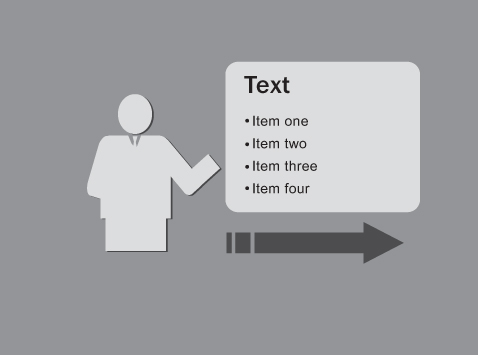78. Right or Left: The Deep Roots of Human Preferences
Olivier Fontana of Microsoft Corporation, whose email about fast talking you read in Chapter 51, “Fast Talking,” also wrote about how right and left preferences affect presentations. His email was prompted by a Newsweek article that reported on a scientific study of personal preferences driven by handedness:
[P]eople with different physical characteristics, such as being right- or left-handed, form different abstract concepts, corresponding to those physical traits. For southpaws, the left side of any space has positive moral, intellectual, and emotional connotations; for righties, the right side does.F78.1
We live in a right-dominant world. Estimates of the right-handed majority range from five to one all the way up to nine to one. This dominance is also reflected in our language; think about the many common phrases that attribute positive values to the right:
• “It’s all right with me”
• “All’s right with the world”
• “My right hand”
• “Right-of-way”
Conversely, think about the many common phrases that attribute negativity to the left:
• “Left out”
• “Out in left field”
• “Two left feet.”
• “Left-handed compliment”
The Latin origins of the words—dexter means “right” and sinister means “left”—carry the same values forward. The French counterpart extends them still further: Gauche means not only “left,” but also “wrong.” Coming full circle, gauche is now part of our English vocabulary meaning “lacking social polish” and “tactless.”
According to some theories, the roots of this division of values go back to our distant ancestors. One comes from Rudolf Arnheim, the author of Art and Visual Perception, a 1954 book that is a bible for cinema students because of its theories governing camera movement. With regard to the left-to-right preference, Mr. Arnheim hypothesized that early humans were influenced by the sun’s movement across the sky from left to right.F78.2
Another theory comes from the web site www.bigsiteofamazingfacts.com:
A person who was born right-handed would fight with a weapon in his right hand and use his left hand to shield himself; a left-handed person would fight with his left hand and shield himself with his right hand. A person who uses his left hand to shield himself protects his heart, which is on the left side of the body. So, many right-handed persons who were wounded would survive, while left-handed persons would suffer wounds around their heart and die.
Over the course of evolution, this higher survival rate among right-handed persons could have led to more persons being born right-handed.F78.3
Whether or not these theories are valid, we have evolved into a right-dominant world—Mother Nature at work.
But nurture is involved, too. In Western culture, we have all learned to read text from left to right. As a result, all movement to the right is more natural and, therefore, more appealing than to the left. This basic imprinting is so potent that it influences all people, both righties and lefties.
The roots of text direction also trace back to our early ancestors, when ancient writing was done on stone with a hammer and chisel. A right-handed person held the hammer in the right hand, the chisel in the left, and wrote right to left, to be able to see the letters forming. Therefore, ancient Hebrew and Arabic text, coming from the Stone Age, reads right to left. When paper and ink came into use, a right-handed person trying to write right to left, would smudge the wet ink; so in newer languages, the direction of text switched.F78.4
In Western cultures today, reading from left to right is so deeply embedded in childhood that it becomes second nature in adulthood. The innate predisposition of the eyes to move toward the right is irresistible. You can feel it as you scan this very page or the hard or soft copy of pages of any book, magazine, newspaper, or web site. Try moving your eyes the opposite way from right to left, and you’ll feel a resistance.
Video and cinema directors incorporate this dynamic in how they direct their subjects and cameras. Watch a well-directed television drama or film and notice how the characters move across the screen. Most often, the sympathetic characters, the heroes and heroines, move from the left side of the screen toward the right, flowing with the natural movement of the eyes. By contrast, the unsympathetic characters, the villains, move from right to left, fighting the eyes’ natural flow.
All these dynamics add up to a significant factor in presentations, with particular regard to the position, movement, and direction of all matters visual. This includes the design and animation of your graphics, and even the positioning of the physical elements of your presentation—as well as you. Whenever you present, put the projection screen to your left as you face the audience:
Figure 78.1. The projection screen should be to your left.
In this arrangement, every time you click to a new slide, the eyes of your audience will travel from you to the screen and across the image easily and naturally. This is especially important with text slides, so that the audience takes in the words on the screen just as they do in a book. If the screen were on the opposite side, the eyes of your audience would have to go backward, against the grain, before returning to take in the words on a second pass.
This same dynamic is applicable to how you animate your slides. Make the default entry movement of all your graphics from left to right, unless you want to send a negative or different message.
You, your slides, and the screen are all subject to these deeply embedded instinctive and learned forces acting upon your audience. When you step up to the front of the room, be sure you make the right choices.

